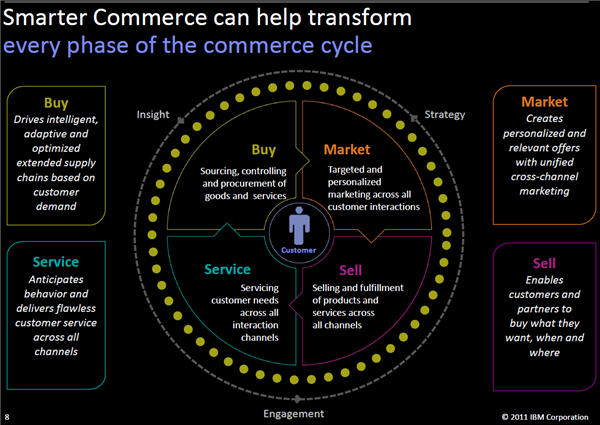Digital Marketing: Understanding customer sentiment
Yuchun Lee, Vice President and General Manager, Enterprise Marketing Management Group, IBM, understands analytics and metrics are, as he puts it, “a huge part of marketers’ lives.”
He says the question then becomes, “How much time and energy should marketers spend checking out metrics and worrying about the analytics of their efforts?”
Yuchun adds, “I think the market trend has been moving towards incorporating more and more data and analysis of customers.”
This includes learning what messaging is relevant to your customers.
“Being able to analyze the data to understand a customer becomes paramount for every business,” explains Yuchun.
This data analysis allows you to determine consumer sentiment, which in turn provides a framework for relevant communications.
The “circles” of consumer sentiment
Yuchun describes the analytics of consumer sentiment as a series of concentric circles that are a way to segment customers and prospects by their value engagement.
Each circle will also define the types of data you should use to analyze different elements of consumer sentiment. The information for consumer sentiment analysis can be found in the huge pipeline of online data available for analysis, including website analytics and social media data.
– The Inner and Middle Circles
He says the inner circle focuses on understanding the absolute best customer you want to service.
The next circle out looks at understanding customers actively engaged in the selling process.
Data for the innermost circles, where you are seeking to understand your customers, comes from information collected while servicing those customers.
Sources for this data include:
- Web behavior
- Reference referral
- Linkages
- Direct feedback to call centers or other channels
The key performance indicators include net promoter scores and feedback from customer surveys. And because the goal is to understand customers, and not prospects, the data and feedback need to come from established relationships.
Other KPIs include metrics around customer satisfaction, issue resolution and time to resolution.
For the middle circle, focused on all existing customers, you also want to look at traffic on the website and the depth of that engagement by tracking time spent on the site.
– The Outer Circle
The outer circle is the broadest set of analytics. It is based on understanding general sentiment around your entire business area or market, and includes both customers and non-customers.
“Basically all the buzz that is happening,” Yuchun states about the outer circle.
The outer circle, where you seek to understand the overall sentiment of the entire marketplace, requires collecting data from social media networks and online communities.
Yuchun says this includes scraping Twitter and other social platforms, and then applying natural language analysis of the unstructured data to uncover sentiment.
He states the goal is to gain “a more macro view of what your brand is like at this moment in time.”
For the outer circle, look for positive and negative mentions on social platforms, association strength based on frequency of mention, and most recent admissions.
Tracking consumer sentiment is valuable for consumer and B2B marketers
“There is a strong history of technology innovation happening in the B2C world, and then migrate towards B2B,” says Yuchun.
He adds the leading edge of that B2B migration is toward businesses with a larger customer base and more broad geographic reach.
“For example, you wouldn’t find consumer sentiment to be as important for the mining industry as it is, for say, the telecom hardware or PC industries,” explains Yuchun.
Go for the steak, not the sizzle
Yuchun says IBM isn’t just doing primary research in the area of consumer sentiment “for fun.”
He thinks this type of data analysis is a huge change happening in marketing. While research is being conducted on brand analysis, IBM is also analyzing earned media and system engagement to help marketers become more relevant to their customers in the future.
“When you look at consumer sentiment, make sure that you think about it in these concentric circles because I think sometimes people go for the sizzle and not the steak,” Yuchun states.
“The steak is what your customers, those high-value customers who are paying the bill, are saying about your business,” he says.
Image courtesy of IBM
Related Resources:
New Chart: Business Technology Websites Benefitting from Continuous Improvement
Content Marketing: Analytics drive relevant content, 26,000 new monthly visits to blog
Web Analytics: Tips from your peers about metrics
Marketing Optimization: How your peers predict customer behavior
Marketing Research Chart: Top data analysis challenges for landing page optimization
Customer-centric Marketing: Tap into your culture to differentiate from the competition
Super Bowl Analysis Takes Us Beyond the Tweets – via IBM’s Smarter Planet blog
Categories: Online Marketing analytics, digital marketing, engagement, metrics, relevance











Good inforgraphic David. Understanding customer is the primary focus for any business. Even spending time in metrics also gives the actual information. Why can’t you check out the video about digital marketing by Infosys BrandEdge. Hope you will enjoy by watching the video.
http://bit.ly/Ob7L0r
Everything should start with consumer study. Unfortunately, many are caught up with their goals and tasks to realize the importance of this.